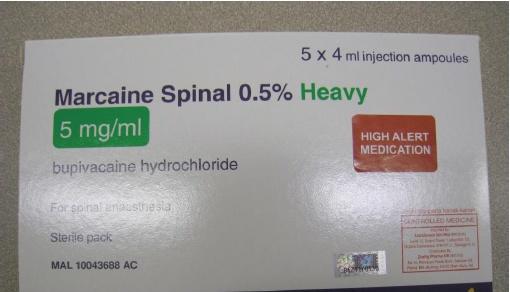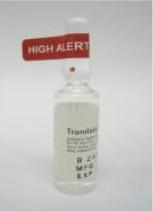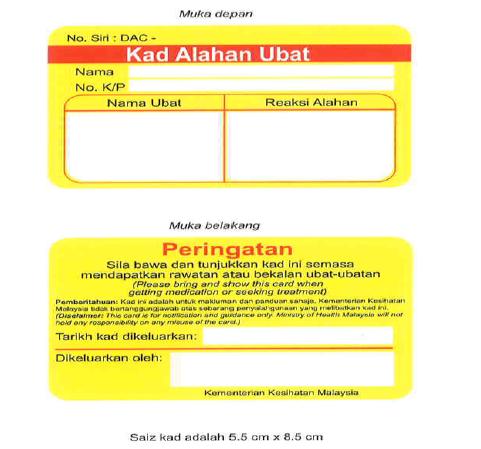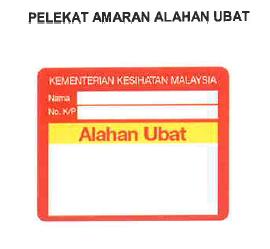Slide
Ext DIS: 5609/6083
PHARMACY BULLETIN
Pharmacy department, hbuk
Inside this issue:
1.
High Alert
HIGH ALERT MEDICATION
Medication
Kad Alahan
Common risk factor:
* Poorly written medication orders.
Olanzapine
* Incorrect dilution procedures.
(Zyprexa vs
* Confusion between IM, IV, intrathecal, epidural preparations.
* Confusion between different strengths of the same medications.
* Ambiguous labeling on concentration and total volume of medications.
Depressive
* Wrong infusion rate.
Disorder
* Look alike or sound alike product and similar packaging.
Strategies to avoid errors involving High Alert Medication
* High Alert Medication should have ‘
HIGH ALERT MEDICATION' labels on storage
medications that
shelves, containers, product packages and loose vials or ampoules.
Prescribing:
bear a heightened
* Do not used abbreviations when prescribing High Alert Medication.
* Specify the dose, route and rate of infusion for High Alert Medication prescribed :
significant patient
(eg: IV Dopamine 5mcg/kg over 1 minute).
Administration: * Label the distal ends of all access line to distinguish IV from epidural lines.
medications are used * Must double checked following particulars before administration:
- Patient's name and RN.
- Name, strength and expiry date of medications.
Editorial Board:
- Dose, route, and rate (pump setting and line placement when
Storage:
* All High Alert Medication should be kept in individual labeled containers.
Whenever possible avoid look-alike and sound-alike drugs or different strenghts of
the same drug from being stored side by side.
* Use TALL-man lettering to emphasize differences in medication names
(eg: DOPamine and DOBUTmaine).
* Label all containers used for storing High Alert Medication as ‘HIGH ALERT
Board of Editor:
Shamini Hu Sze Qian





1. Adrenergic Agonist, IV
11. Glyceryl Trinitrate Injection
(eg: adrenaline, noradrenaline)
2. Adrenergic Antagonist, IV
12. Inotropic Medications, IV
(eg: propanolol, labetalol)
(eg: digoxin, dobutamine, dopamine)
3. Anaesthetic Agents, general, inhaled and IV
13. Insulin, Subcutaneous and IV
(eg: propofol, ketamine, dexmedetomidine)
4. Antiarryhtmias IV
14. Magnesium Sulphate Injections
(eg: lignocaine (lidocaine), amiodarone)
5. Antifibrinolytics, Hemostatic
15. Moderate Sedation Agents, IV
6. Abtithrombotic Agents
16. Neromuscular Blocking Agents
(eg: warfarin, heparin, tenecteplase,
(eg: pancuronium, atracurium,
rocuronium, vecuronium)
17. Opiates and Narcotics
(eg: Sea snake, cobra, pit viper antivenom)
8. Chemotherapeutic Agents Parenteral and
18. Parenteral Nutrition preparations
9. Dextrose, Hypertonic, 20% or greater
19. Potassium Salt Injections
10. Epidural and Intrathecal Medications
20. Sodium Chloride Solution (greater than 0.9%)
Reference: Guideline On Safe Use of High Alert Medication, Pharmaceutical Services Division, Ministry of Health Malaysia
Prepared by: Noor Shakila Bt Mohd Rodi (U44)



Alahan ubat merupakan kesan ubat yang
tidak diingini yang diberikan pada dos biasa
untuk tujuan pencegahan penyakit, diagnosis
atau rawatan. Kesan alahan ubat adalah
memudaratkan malah boleh menyebabkan
kematian.
Kad alahan ubat yang akan diberikan
Pelekat amaran alahan ubat ditampalkan
pada buku rekod pesakit / kad rawatan
Rujukan: Garis Panduan Pengesan Pesakit dengan Alahan Ubat
Prepared by: Noor Shakila Bt Mohd Rodi (U44)
Major depressive disorder
Major Depressive Disorder is expected to be the 2nd largest contributor to the global disease burden after cardiovascular disease. Hence it incurs substantial cost both in public and economic. Depression is often under-recognised and under-treated. It has been estimated that about 30-50% of depression are undetected in both primary care and medical setting. Antidepressants are normally used in treating depressive symptoms. However the different types of antidepressants has its' own various adverse effects.
The table below is the list of antidepressants available in HBUK and
suggested dosage and adverse effects.
Venlafaxine (ER),
Fluoxetine, Escitalopram.
Fluvoxamine, Sertraline
Starting
Usual dose
Drug name
Main adverse effects
range (mg)
(mg/day)
Tricyclics and Tetracyclics
Sedation, often with hangover, postural
hypotension, tachycardia , arrhythmia, dry mouth,
blurred vision, constipation, urinary retention
As above but less sedative
Starting dose
Usual dose
Drug name
Main adverse effects
(mg/day)
range (mg)
Selective Serotonin Reuptake Inhibitor (SSRIs)
Nausea, vomiting, dyspepsia, abdominal
pain, diarrhea, rash, sweating, agitation, anxiety, headache, insomnia, tremor, sexual dysfunction (male and female),
hyponatraemia, cutaneous bleeding disorder. Discontinuation symptoms may occur.
As for escitalopram but insomnia,
agitation and rash more common. May alter insulin requirements.
As for escitalopram but nausea more
Reversible Inhibitor of MAO-A (RIMA)
Sleep disturbances, nausea, agitation,
confusion. Hypertension reported-may
be related to tyramine ingestion.
Noradrenergic and Specific Serotonergic Antidepressant (NaSSA)
Increased appetite, weight gain,
drowsiness, oedema, dizziness,
headache, blood dyscrasia.
Nausea/sexual dysfunction relatively
Serotonin And Noradrenaline Reuptake Inhibitors (SNRIs)
Nausea, insomnia, dry mouth,
somnolence, dizziness, sweating,
(up to 375mg/day
Venlafaxine (ER)
nervousness, headache, sexual
dysfunction. Elevation of blood pressure
at higher doses. Nausea, insomnia, dizziness, dry mouth,
somnolence, constipation, anorexia.
Very small increase in heart rate and
blood pressure, probably clinically
Reference: CPG Depression 2007
Prepared by: Hu Sze Qian (U44)
OUR NEW SERVICE !!!
Schizophrenia medication
therapy adherence clinic
Medication therapy adherence clinic (MTAC) is a part of the Clinical pharmacy services in an ambulatory clinic setting. It can be said as an extension to the out patient pharmacy services and part of the non dispensing roles of pharmacist. First started around 2004, MTAC clinics run by pharmacist in Ministry of Health (MOH) facilities has since grown into a vital and important service scope. It has provided an avenue to the pharmacists to provide a more comprehensive pharmaceutical care and improve overall adherence of patient, better manage side effects and reducing cost of treatment. By emphasizing medication management, pharmacist running MTAC services provide counseling to patient to improve their ability to better manage their diseases and thus improving patient quality of life.
Many literature reviews have repeatedly proven that involvement of pharmacist in patient care will provide a better management of their illness and a more positive therapeutic outcome. Furthermore, making patients to adhere towards medication has always been a herculean task. Non adherence has been found typically high among patients. The rate is said to be the highest among psychiatric patient. Studies have shown that non adherence ranges from 40-50 % among patient suffering from schizophrenia. Non adherence patients will have 3.7 fold risk of relapse compared to patients who adhere to treatment.
About S-MTAC…
Pharmacy Department Hospital Bahagia (HBUK) have started Schizophrenia Medication
Therapy Adherence Clinic (S-MTAC) since March 2012.
This clinic operates form the Out-patient pharmacy department, which is located in the
Specialist Clinic Block.
The clinic opens every working day from 8.00am to 5.00pm.
There are currently 1 full time pharmacist dedicated to run the services, she is assisted by
another part-time clinical pharmacist.
S-MTAC pharmacist will be seeing the patients on the same appointment day with their
treating doctor. However patient can be also given follow-up appointment for extra
counseling section if needed.
Any schizophrenia patient with compliance issue, who deem suitable for S-MTAC can be
referred by their treating Specialist or Medical Officer. Patient are sometime identified
and referred by fellow pharmacist during dispensing or discharge counseling.
Patient selections are usually among patient suffering from schizophrenia and fulfill any of
the criteria below:
Newly diagnosed schizophrenia patient.
Patient who have been started with a new antipsychotics drug.
Schizophrenia patients with compliance problem.
Besides counseling using the 5 psychoeducation module, S-MTAC pharmacist will also help the doctors to identify and monitor side effects, provide education materials to patient, assess compliance using various methods such as Modified Morisky Scale and pill count, provide compliance assisting tools like pill box and medication chart to help improve patient compliance. They are also responsible to communicate all drug related problems with the treating Specialist or Doctor and suggest changes wherever possible.
Activities of S-MTAC
Side effect monitoring by Pharmacist
Counseling section by Pharmacist
– measuring BMI for Metabolic Syndrome
– with patient and with caregiver
Prepared by: Shamini (U48)
Makluman status pendaftaran ubat dalam Formulari Ubat KKM.
•
Procyclidine HCL 10mg/2ml inj. (Kemadrin)
- Telah berdaftar dan terdapat dipasaran.
- Tidak memerlukan kelulusan Pengarah Kanan
Perkhidmatan Farmasi dan permit import.
- Terdapat di HBUK
Ubat-ubat baru yang diluluskan dan dimasukkan ke dalam
Formulari Ubat KKM
•
Desvenlafaxine succinate 50mg (ER) tab. (Pristiq)
Agomelatine 25mg tab. (Valdoxan)
Tambahan kekuatan/formulasi ke dalam Formulari Ubat KKM
•
Amoxycillin 500mg cap.
Cloxacillin 500mg cap.
Memantine HCL 20mg tab.
Quetiapine 100mg IR tab.
Quetiapine 200mg IR tab.
Valproic Acid and Sodium Valproate 500mg tab. (Epilim Chrono)
Epilim Chrono
Sodium Valproate 333mg /
Active ingredient(s)
Sodium Valproate 200mg
Valproic Acid 145mg
Tablet Identification
Enteric coated tablet
Controlled release tablet
Rujukan: Formulari Ubat KKM
Prepared by: Noor Shakila Bt Mohd Rodi (U44)
Source: http://hbuk.moh.gov.my/v3/images/farmasi/buletin/buletinfarmasibil1_2013.pdf
KING GEORGE MEDICAL UNIVERSITY (Office of the Superintendent) Gandhi Memorial & Associated Hospitals Uttar Pradesh, Lucknow - 226003 Telephone: (0522) 2257450-3 Fax: (0522) 2257450 Website: www.kgmcindia.edu COMPETITIVE E-BIDDING FOR SUPPLY OF MEDICINES FOR VARIOUS DEPARTMENTS OF GANDHI MEMORIAL & ASSOCIATED HOSPITALS, KING
Bluetooth GPS Receiver User's Guide HOLUX Technology Inc. 1F, No. 30, R&D Rd. II, HsinChu City 300, Science-based Industrial Park, Taiwan TEL: 03-6687000 FAX: 03-6687111 E-Mail: [email protected] Website: www.holux.com.tw All Right Reserved Date: 031705 Still HOLUX GPSlim236 Wireless Bluetooth GPS Receiver Manual Table of Contents








